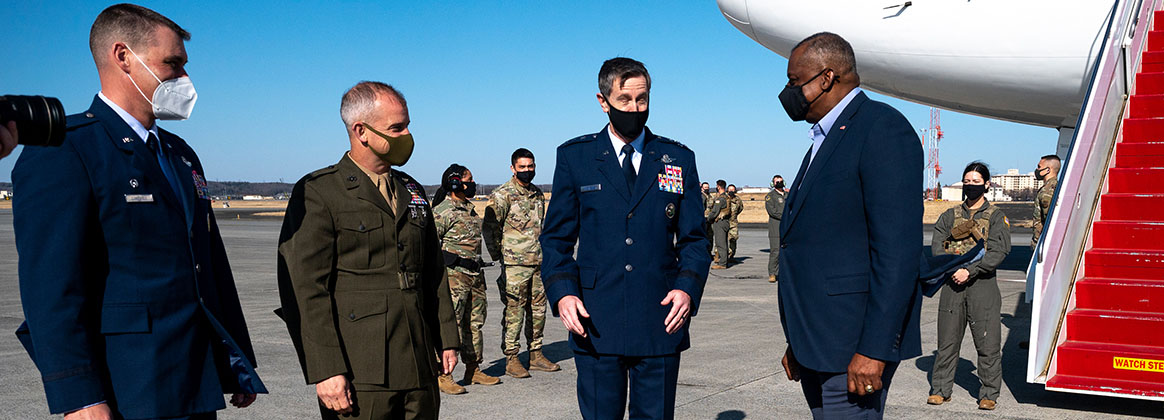Having signed the four basic US military foundational agreements necessary for interoperability – the last of those in October 2020 – the Narendra Modi government will now be taking India’s military relationship with the United States several notches higher. If things move at the government’s pace, India will soon be a de facto US ally without any clarity on how this will enhance the country’s defence against the combined China-Pakistan threat. Or how it would help establish geopolitical equilibrium with China.
When US secretary of defence Lloyd J. Austin III comes to India (March 19-21) after his visits to Japan and South Korea – both formal US allies in Asia – on the table for discussion will be the Pentagon’s multi domain operations (MDO) warfighting concept. That this is in the offing was indicated by the army chief, General M.M. Naravane during his February 24 address at a webinar organised by the Vivekanand International Foundation (VIF). According to Gen. Naravane, multi domain operations are the future of war for which the Indian Army is preparing.
Coming to grips with the shift in US military thinking
While the army chief’s sudden switch to MDO from network-centric operations (NCO) may have come as a surprise to many, the national security advisor, and by extension the Prime Minister’s Office (PMO), had been working the ropes to get under the broader and more definitive US security umbrella. I believe that the NSA’s office was acquainted with the idea of MDO during the Ladakh crisis, when in desperation the government was looking at all options to counter China. These included seeking non-traditional (by Indian thinking) means as well. A few start-ups, familiar with some of the technologies involved, have been working with the NSA’s office on developing an Indian version of MDO. This was the reason the Modi government rushed to sign Basic Exchange and Cooperation Agreement (BECA) last year even when it was unclear if Trump administration would return to power.
The Biden administration is determined to do more than incorporate allies and partners (like India) into its MDO warfighting concept. Even before the US Indo-Pacific commander (INDOPACOM), Admiral Philip Davidson recently told the Senate Armed Services Committee that Chinese military aggression towards Taiwan and India could manifest ‘in fact in the next six years’, the White House had asked the Pentagon to conduct a task force review on how to meet the Peoples Liberation Army (PLA) challenge in Asia. Senior US officials, including the joint chiefs chairman, General Mark Milley, have gone public in suggesting what steps needed to be taken to stem the US military downslide.
The steps suggested by US military officers are meant to address two major issues: How to meet the PLA’s anti access and area denial (A2AD) challenge, and how to strengthen US military’s conventional deterrence by MDO.
A2AD is the US military term for what the PLA calls its counter-intervention strategy comprising its long and medium range ballistic missiles, hypersonic and supersonic cruise missiles, early warning and long-range radars, integrated air and missile defence system, long range reconnaissance satellites and aircraft, cyber, electronic, and counter space capabilities. The counter-invention strategy or A2AD weapons are meant to disallow US military access to its bases, and to deny force operational freedom of action once there.
At the heart of this strategy is China’s systems destruction warfare exemplified by its awesome projective-centric (missiles) warfare and ability to destroy US networks which connect its kill chain. The latter also called the Observe, Orient, Decide, and Act (OODA) loop is a three-part process consisting of understanding the situation, deciding on the course of action at the command-and-control operating centres, and ordering the appropriate shooter (missiles, guns, laser guided bombs, laser weapons, cyber weapons, jamming, counter space weapons) to destroy the targets.
The US military’s three priorities
US military officers say that the A2AD challenge is huge and requires three actions to meet it. First, the US should increase its missiles production rapidly. The Trump administration had withdrawn from the Intermediate Nuclear Forces (INF) treaty in 2019 since it prevented the US from building conventional land-based missiles over 500km range. Since China was not part of this treaty, it could unabashedly test and operationalise ballistic missiles in large numbers unmatched by any nation.
The second action relates to the challenge of PLA’s long ranges and accurate missiles, especially when they would soon be enabled by artificial intelligence (AI) imbedded in them. These ‘intelligent’ missiles, called lethal autonomous weapons (LAWs) would be able to operate independently. Able to accomplish given tasks by themselves, LAWs would not require software networking communication with the human controller. Incidentally, this network which connects the missile to the control station is its most vulnerable part. It can be destroyed by the adversary – in China’s case, by the US – thereby blinding the missile.
The answer to this problem, the US military says, is to abandon its limited and permanent Asian bases with a high density of troops in places like Japan, South Korea, and Guam. Established after the Second World War, these would be easy targets for PLA missiles. Instead, the US should seek diffused bases, at many places, where troops could be placed on a rotational basis. It is argued that dispersed and expeditionary US troops across the INDOPACOM would be a less vulnerable target and provide better conventional deterrence. Looking for such bases amongst partners in the region would be a high priority for US defence secretary Austin when he meets India’s NSA.
Would the Modi government, which has gone out of its way to seek US security, refuse an American request for rotational troops on Indian soil?
The third action the US military intends to take is to permanently position the US army-led multi domain task force (MDTF) closer to the Chinese A2AD firewall to potentially penetrate it before a major attack is mounted by the US forces arriving from rotational bases. The MDTF would comprise long-range US missiles and cyber capabilities (under the US army cyber command) meant to destroy PLA missiles.
India and the US warfighting concept
Interestingly, at the aforementioned webinar, General Naravane spoke about the need to address the PLA’s ‘grey zone capabilities short of war’ by the framework of the Chief of Defence Staff (CDS) and the Department of Military Affairs under him. The ‘grey zone’ referred to the PLA’s capabilities in the virtual domains of cyber, space, and electronic (electromagnetic spectrum) warfare. According to the army chief, India’s defence cyber agency under the CDS and the army’s demonstrated swarm drone capability on Army Day on January 15 would be able to hit the A2AD bubble.
Since this is wishful thinking, will India ask the visiting US defence secretary to help raise an India-specific MDTF with capabilities procured from the US across the Line of Actual Control (LAC) between India and China? After all, the PLA has raised a smaller version of the A2AD firewall it has for Taiwan – the distance between Taiwan and mainland China is 110 miles. If India goes down this path, the presence of US military experts close to the LAC could make China review its India strategy, leading perhaps to an escalation neither wants.
Defence secretary Lloyd would likely discuss India’s involvement in the US’s MDO warfighting concept with Ajit Doval, with perhaps the CDS in attendance. The MDO involves the virtual networking of long-range fire, electronic, space and cyber warfare capabilities with the physical war domains of land, air, sea, and information operations. It would involve MDO command-and-control or operating centres where information from all listed entities/weapon systems from all domains would come at a central place for decision-making to close the kill chain faster than the enemy.
The MDO operating centres, depending upon the level of headquarters, would be huge halls with umpteen computers manned by service personnel from all arms and services sitting together to make sense of the information pouring in at the speed of light in nanoseconds. There is difference between data and information which should be understood. Raw data on situational awareness procured by thousands of miniaturised sensors (electro-optical, radars, infrared, lidar, numerous acoustic sensors) placed in physical war domains would be processed instantly by edge computing. Making sense of the raw data, edge computing would turn it into actionable information which would then be passed to the MDO operation centres. The latter, which will include senior officers from all services, will then take quick decisions on action to be taken on the information coming to them.
At present, the US’s individual services have their own version of MDO with two shortcomings: First, the services (army, air force, navy, marines and space force) need to interact with one another usually by voice calls and data transfer, which is an archaic way of communication. And second, software networks which link various systems or nodes are inflexible with industrial age architecture which can be destroyed by the PLA’s system destruction warfare, leaving commanders blind. General Milley has proposed a ‘joint warfighting concept’ – Joint MDO – whereby all services would be networked, bringing information into single MDO operating centres for all three services. Thus, instead of fighting wars as army, air force, navy, marines, and space forces, the US military would fight wars as a nation with allies and partners in INDOPACOM. The underlining idea of ‘joint warfighting concept’ would be to make data/information from all war domains available to every participant including allies and partners into their MDO operating centres.
What India needs to ask itself
However, all this leads to critical questions. Would India be a part of the bigger US MDO for INDOPACOM? Or would it seek US help in setting up its own MDO operating centres? If yes, what purpose would they serve considering the Indian military understands warfare only in physical domains with the army as the lead service. Endorsing the MDO concept would require, in the least, the Indian Army to shift away from the outdated concept of massed territorial profile of defence and offense. More importantly, are the Indian military and the NSA/CDS working on different warfighting concepts, totally removed from one another? What about the much-publicised military reforms announced by the CDS?
The problem does not end here. Worried about the PLA’s intelligent, autonomous, and thinking software networks with AI inserted into them, the US military, in 2017, had asked its Defence Advanced Research Projects Agency (DARPA) to improve technology and warfighting concepts to match the PLA’s AI enabled intelligenised warfare. The latter is a total break from the mechanised, network centric, and MDO concepts of the past and the present. In this new warfare, which is referred to as mosaic or algorithmic warfare by DARPA, technology would not support humans, but replace them. It would become algorithmic war – one algorithm fighting with the algorithm of the opposing side. This software driven war would have intelligent networks, intelligent internet, intelligent military internet of things, and intelligent weapons. This would be a reality soon.
Once that comes about, the evolving US Joint MDO concept would need to make major changes in doctrines, concept of operations, and force structuring. The big change would be the removal of most MDO operating centres since most machines would communicate directly with machines within the US military and perhaps with the machines of allies and partners. To the numerous sceptics in India, frozen in military thinking, Intelligentised war, according to China would be a reality by 2027, much quicker against India, perhaps by 2024.
India’s limitations are real
The Indian military is far removed from intelligentised warfighting. This was evident from General Naravane’s assertion, made twice in the VIF webinar, that while the character of war changes constantly, the nature of war does not change. ‘Nature of war’ refers to defining the war, which is violence and bloodshed, and ‘character of war’ is how it would be fought, and refers to technology and war fighting concepts. With technology replacing human soldiers in combat, there would be little bloodshed and violence. This would, for the first time in global war history, change the nature of war. This should give an idea of where warfare is headed, and once India hitches on to the US military bandwagon there would be no coming back.
India lacks capability, capacity, indigenous military-industrial complex, and above all military intellect to understand the deep hole we might get into by accepting any of US secretary Lloyd’s proposals for cooperation in combat. Surely, India would not want to get into an avoidable war with China when the possibilities of crafting a smart strategy for peace in the region exist.
































